As part of two distinct awards, the National Save the Sea Turtle Foundation (NSTSTF) is building FIU’s capacity to support research related to the conservation of sea turtles. The two awards include:
- NSTSTF Undergraduate Scholarship
- NSTSTF Sea Turtle Rehabilitation and Outreach Award.
These awards are only available for current undergraduate students.
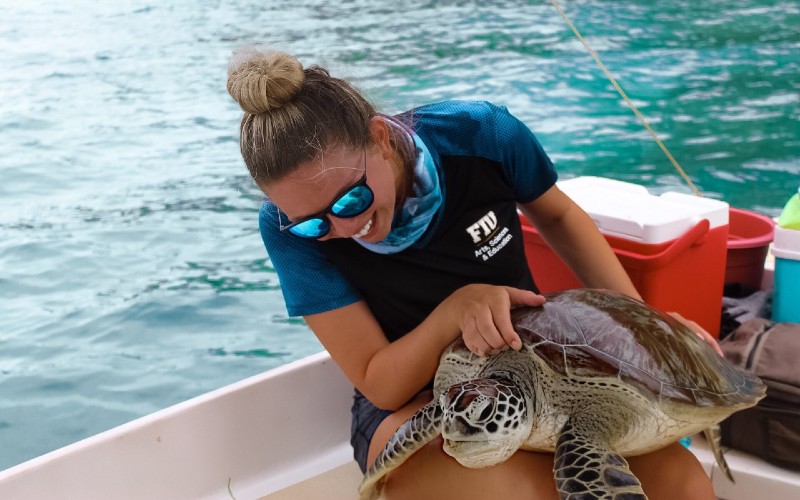
Award Information
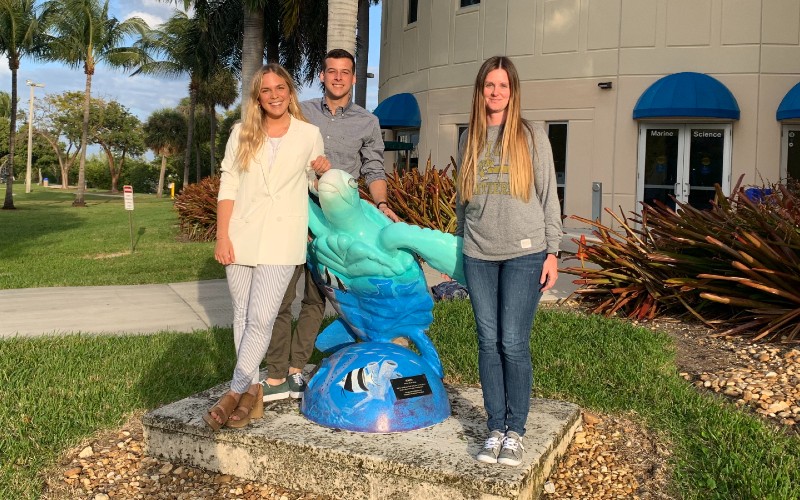 The NSTSTF Undergraduate Scholarship Award will provide up to $8,000 to two undergraduate students who are performing research relevant to the conservation of sea turtles. These funds can be applied toward research-related travel, conference travel, materials and supplies, and student tuition and fees.
The NSTSTF Undergraduate Scholarship Award will provide up to $8,000 to two undergraduate students who are performing research relevant to the conservation of sea turtles. These funds can be applied toward research-related travel, conference travel, materials and supplies, and student tuition and fees.
The application package for the NSTSTF Undergraduate Scholarship Award includes the following:
- A 500-word personal statement that includes how the chosen opportunity (see list below) will help you meet your career goals, aspirations, and research interests
- CV or resume
- 2 letters of recommendation. Must speak to skills related to research and reliability / character.
- A copy of the student’s unofficial transcript
Notes:
1) Students who choose to create their own internship or research project have additional components that need to be included in their applications. See more information about these additional requirements in the 'Create an Independent Research Project' section below.
2) Students also have the option of obtaining academic credit for their participation in the program. If you are interested in obtaining credit, please indicate this in your application.
Application packages must be formatted into one PDF and emailed to Catherine Guinovart, Coordinator of Administrative Services for the Coastlines and Oceans Division in the Institute of Environment at cguinova@fiu.edu before January 26th, 2024.
If a student is applying for the NSTSTF Undergraduate Scholarship Award the subject line of the email should be “NSTSTF Scholarship Student’s Last Name”. The letters of recommendation for the scholarship should be emailed to cguinova@fiu.edu with the subject line “LOR NSTSTF Scholarship Student’s Last Name".
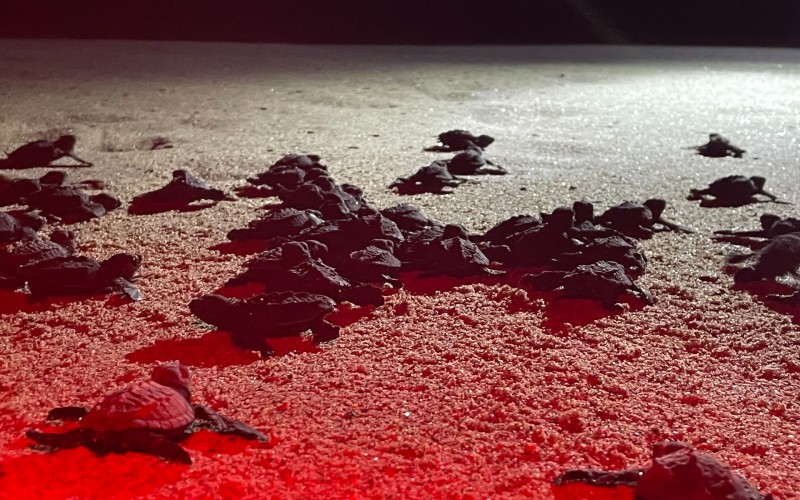
The NSTSTF Rehabilitation and Outreach Award will provide stipends of up to $2,500 to support three students who are participating in sea turtle rehabilitation and outreach efforts through internships. This can include internships at any local zoos or aquariums, relevant nonprofit organizations, or other local entities performing sea turtle rehabilitation and outreach.
The application package for the NSTSTF Rehabilitation and Outreach Award includes the following:
- A 500-word personal statement that includes how the chosen opportunity (see list below) will help you meet your career goals, aspirations, and research interests
- CV or resume
- 2 letters of recommendation. Must speak to skills related to research and reliability / character.
- A copy of the student’s unofficial transcript
Notes:
1) Students who choose to create their own internship or research project have additional components that need to be included in their applications. See more information about these additional requirements in the 'Create an Independent Research Project' section below.
2) Students also have the option of obtaining academic credit for their participation in the program. If you are interested in obtaining credit, please indicate this in your application.
Application packages must be formatted into one PDF and emailed to Catherine Guinovart, Coordinator of Administrative Services for the Coastlines and Oceans Division in the Institute of Environment at cguinova@fiu.edu before January 26th, 2023.
If a student is applying for the NSTSTF Rehabilitation and Outreach Award the subject line of the email should be “NSTSTF RO Award Student’s Last Name”. The letters of recommendation for the scholarship should be emailed to cguinova@fiu.edu with the subject line “LOR NSTSTF RO Award Student’s Last Name”.
Available Opportunities
- Marine Environmental Education Center
Option 1: Education
To participate in the development and expansion of educational programming through the Marine Environmental Education Center at the Carpenter House under the direction of the Director of Carpenter House MEEC Program, Marine Turtle Caretaker/Permit Holder, MEEC Sea Turtle Education Specialist, and the Dean of the Halmos College of Natural Sciences and Oceanography. Specific tasks will include:
- Work on and contribute to collaborative education/outreach teams
- Perform outreach activities and integrate scientific knowledge and operational expertise to ensure excellence in development and translation of research/outreach
- Communicate with local teachers and schools
- Assist in the planning and scheduling of school field trips
- Host center tours for the public and school groups
- Classroom management and implementation of new programs
- Assist in organizing supplies and activities for programs
- Help schedule educational workshops at the MEEC
- Assist in daily operations of Carpenter House MEEC facility
- Work with the public to educate kids and adults about sea turtles and other marine species
- Other duties as assigned
Option 2: Husbandry
To assist in animal care and life support systems at the Marine Environmental Education Center at the Carpenter House under the direction of the Director of Carpenter House MEEC Program, Marine Turtle Caretaker/Permit Holder, MEEC Sea Turtle Education Specialist, and the Dean of the Halmos College of Natural Sciences and Oceanography. Specific tasks will include:
- Assist in monitoring and caring for animals at the MEEC
- Prepare animal food
- Evaluate animal wellbeing and notify care-taker of any issues
- Collect daily and weekly water quality data
- Assist in the maintenance of life support systems (ex. Rinsing equipment, backwashing, etc.)
- Complete animal care logs, such as feeding and fecal information
- Maintain animal facilities, such as scrubbing and removing waste
- Complete and compile animal care data
- Host center tours for the general public and school groups
- Assist in daily operations of Carpenter House MEEC facility
- Work with the general public to educate kids and adults about sea turtles and other marine species
- Other duties as assigned
- Florida West Coast
Sea turtle patch preference based on movement between seagrass meadows in St. Andrew and St. Joe Bay
Seagrass meadows within St. Andrew and St. Joe Bay have experiences enhanced grazing pressures from herbivores such as green sea turtles, which has negatively impacted seagrass growth in St. Joe Bay, especially since Hurricane Michael in 2018. Much research has been done on this occurrence in St. Joe Bay, but not St. Andrew Bay and this project aims to close this research gap. Along with enhanced grazing pressures, seagrass meadows within these bays also experience mechanical damage from extensive boat propellor scars and seasonal variation of environmental conditions. This project will compare green turtle foraging patterns between seagrass meadows with varying environmental stressors within St. Andrew and St. Joe bays. We will also determine if and how the conservation of seagrass is linked to sea turtle conservation. For this project, students will:
- Work closely with a FIU graduate student
- Conduct visual surveys in seagrass meadows
- Calculate sea turtle abundance
- Conduct seagrass surveys in bays
- Collect environmental measurements that may affect green turtle distribution
- Simulate environmental stressors on seagrass meadows
- Compare and link seagrass meadow conditions to sea turtle foraging
- Design poster conveying results from project to present at research conferences
- Disseminate results in a scientific article
- The Science Exchange
Option 1: Sargassum accumulation on the sea turtle nesting beach at Akumal Bay, Mexico
There are two species that nest on the beaches at Akumal: the loggerhead turtle (Caretta caretta) and the green turtle (Chelonia mydas). You can find them feeding in Akumal bays, and sometimes you can see the hawksbill turtle (Eretmochelys imbricata) around the reef or an occasional nester. Turtles return to their natal nesting beaches to lay their own eggs. But sometimes these beaches are no longer suitable habitat for egg-laying and incubation. One of the reasons can be too much sargassum on the beach to move around to find a spot to lay eggs. Sargassum has also been plaguing the Caribbean tourist beaches for the past few years. Specific tasks for this project include:
- Work closely with The Science Exchange director and local research site supervisor
- Quantifying sargassum abundance and age with transects along beach
- Quantifying turtle nests along the same transects
- Participating in night patrols for nesting turtles and nest excavations
- Compare nesting and hatching success with sargassum metrics
- Prepare results to present at the research center and other conferences
- Write up results in a scientific journal format
*We encourage applicants to apply in pairs since this work will take place abroad.
Option 2: Impacts of artificial sea turtle nurseries on sea turtle hatchlings at Nayarit, Mexico
The study will take place in Nayarit along Mexico’s west coast which has some of the highest olive ridleys (Lepidochelys olivacea) nesting densities in the world. Nests left on the beach are taken by animals or poachers and the beaches are eroding quickly from hard structure developments and heavy storms. Therefore, 100% of nests that are found by permit-holding conservation groups are moved to safer areas such as a fenced beach hatchery or to polystyrene (Styrofoam) boxes stored in a building (box nursery). Because of the unknown consequences of the box nursery technique on hatchlings, it is crucial to test differences in hatchling quality to assess their ability to survive the oceans and reproduce. Specific tasks for this project include:
- Work closely with The Science Exchange director and local research site supervisor
- Conduct nightly beach patrols for nesting turtles
- Relocate nests
- Conduct community service with local supervisor
- Keep a detailed research journal
- Collect data on hatching success, hatchling physical fitness, and environmental variables
- Write a final report or draft a scientific paper
- Present results to local stakeholders and at a scientific conference
- Practice/perfect your Spanish
- Create an Independent Research Project
Students also have the option of proposing any sea turtle-related internship (up to $2,500) or research project (up to $8,000) instead of applying under one of the provided options.
Students who choose to apply for the NSTSTF Rehabilitation and Outreach Award funding must provide the following information in addition to the general NSTSTF application requirements if they want to do an independent research project:
- A brief overview of the sea turtle-related research and/or education activities that will be conducted as a part of the internship. This will also include a description about the organization that will support the internship activities.
- A list of the specific tasks that will be conducted through the internship
- A letter of recommendation from the internship supervisor
- A description of the supervisor’s role in the organization and how they will support the student, signed by the supervisor
Students who are applying for the NSTSTF Undergraduate Scholarship Award funding must provide the following information in addition to the general NSTSTF application requirements if they want to do an independent research project:
- A 1000-word research proposal
- A description of the research site
- A description of who the student will work with in support of the research project
- A detailed budget and budget justification describing how the funds will be used to support the project
- A letter of recommendation must be from a FIU faculty member who will work alongside Elizabeth Whitman to advise students on their research projects
Awardees of the NSTSTF Undergraduate Scholarship Award
- Aloyse Abreu
Aloyse Abreu studied the foraging behavior of sea turtles off the coast of Saona Island in the Dominican Republic, which has coral reefs and seagrass pastures adjacent to it.
Understanding their foraging behavior is important because it allows us to assess how they interact and thus affect the coastal ecosystems. For her novel study, Ishe used a DJI drone to conduct aerial surveys of the habitats to quantify turtle abundance, as well as turtle-borne cameras to identify individual foraging preferences and track their movements between habitats.
Overseen by Dr. Elizabeth Whitman, Abreu’s research will allow scientists to develop a better understanding of sea turtle populations and their interactions with the local environment, which opens the door to understanding their role in the wider Caribbean region.
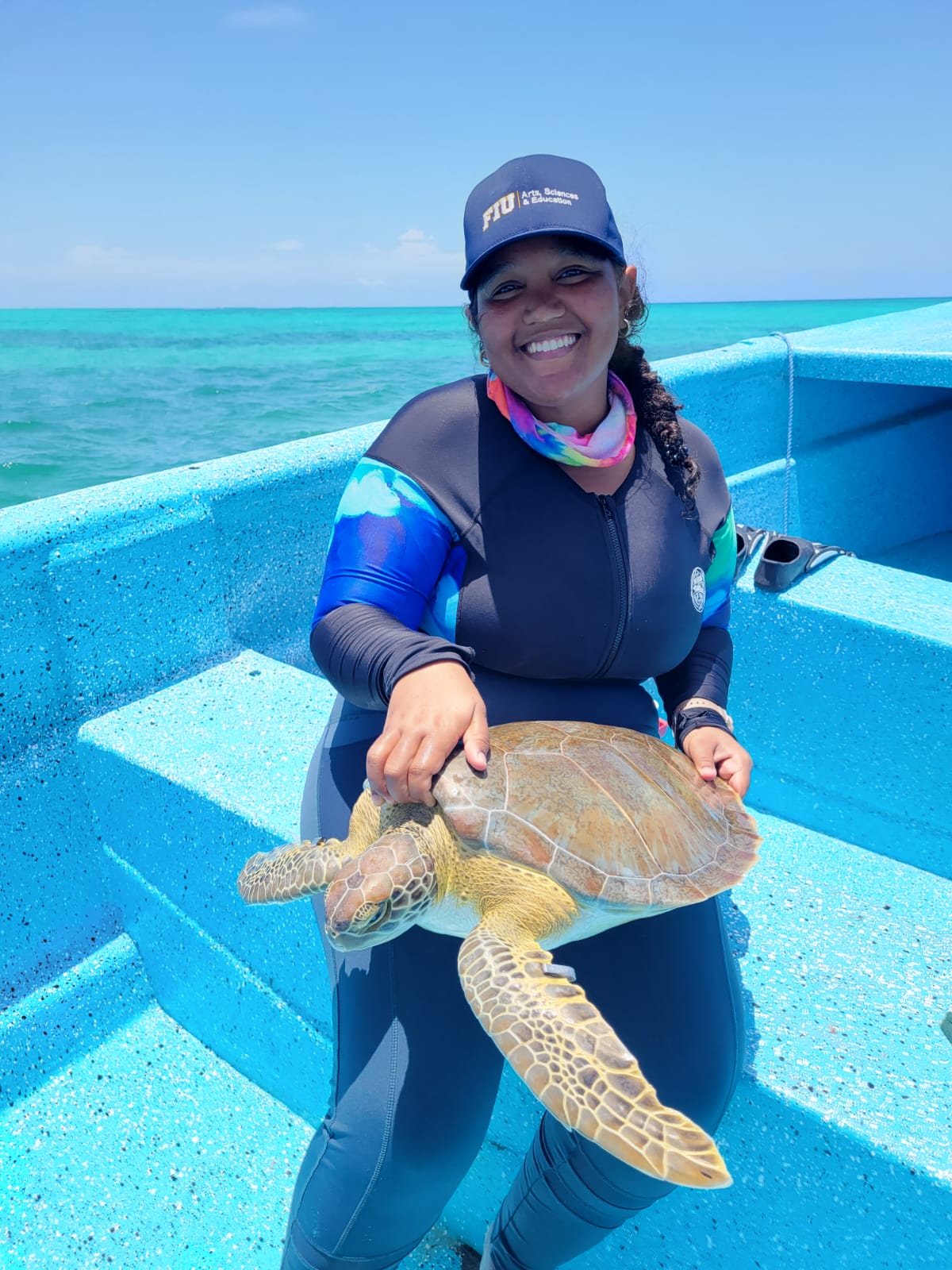
- Mia D'Orazio
Mia D'Orazio studied the interaction of tourists, seagrass cover, turtle density, and behavior in the Bay of Akumal, Mexico.
In the bay of Akumal, the seagrass meadows have high levels of nutrients from contamination of the shallow ground water table, sewage, and agricultural runoff. Other stressors for seagrass in this region are the continuous grazing by a growing population of green sea turtles and sediment and seagrass root disturbance by the great influx of tourists swimming and snorkeling. D'Orazio's work included seagrass, turtle, and fish identification. She collected seagrass surveys to observe abundance, species richness, and shoot density in comparison with historical data. She surveyed human activities (i.e., swimming, snorkeling, scuba diving) to observe spatial distribution patterns. Also, she recorded data on sea turtle abundance to determine their spatial distribution relative to the data she collected on seagrass and human activities.
Overseen by Dr. Elizabeth Whitman, D'Orazio’s research will help scientists better understand the relationship between seagrass, sea turtles, and pressures caused by tourism, so that scientists can gain insight to help better manage this ecosystem.
- Maria Clara Figueredo and Jose Bisbe Ochoa
Maria Clara Figueredo and Jose Bisbe-Ochoa studied whether polystyrene boxes, collected as recycling, can serve as effective incubators in hatcheries.
This work is critical as a major concern for sea turtle hatchlings is the increasing temperatures of beaches and sand. The temperature of developing eggs determines whether offspring will be male or female, and that means higher temperatures could result in a disproportionate number of females — a major problem for the sea turtle conservation.
Overseen by Dr. Elizabeth Whitman, Figueredo’s and Bisbe-Ochoa’s research will help conservationists better protect sea turtle eggs and hatchlings from threats like poachers and storms.
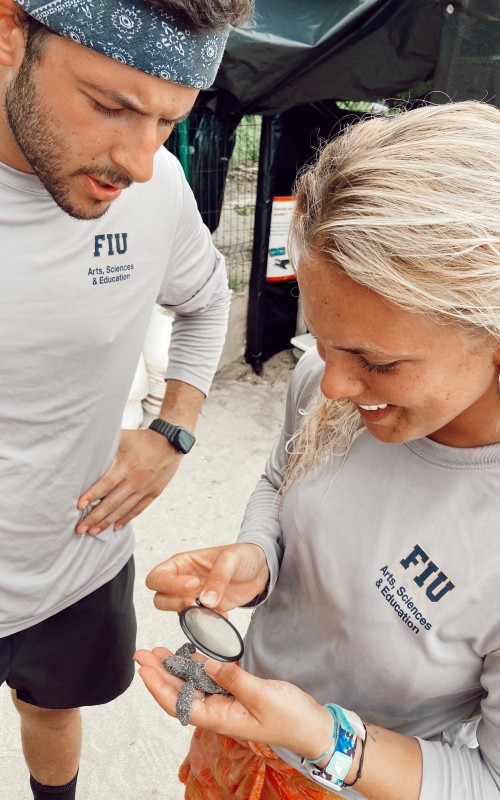
- Samantha Olszack
Samantha Olszack studied how sargassum decomposition causes trace metals, such as arsenic, to leech into the sediment, which may be harmful to the turtles and their young.
Anomalies in El Niño events, increasing ocean temperatures, changes in nutrient abundance, and other threats related to climate change have led to increasingly large amounts of sargassum on South Florida and Caribbean beaches. While sargassum is a critical ecosystem for young sea turtles in the open ocean, accumulations on shore can gather as high as 3 to 6 feet creating obstacles for both female sea turtles searching for suitable nesting areas and hatchlings exiting their nests, which is why understanding the effects of these sargassum landings is critical for sea turtle conservation.
This research is overseen by Dr. Ligia Collado-Vides, a marine botanist in FIU’s Institute of Environment, and could help scientists find ways to manage incoming sargassum and determine possible uses for it, including compost.

- Liberty Boyd
Liberty Boyd is a fourth-year Ph.D. student studying green sea turtle populations and how they use seagrass ecosystems.
Sea turtles rely heavily on the abundance and health of seagrass ecosystems, which serve as their primary food source.
This research is overseen by CASE Executive Dean, Mike Heithaus, a marine biologist specializing in the ecological importance of large marine species. Liberty’s research helps scientists understand the relationship between sea turtle’s seagrass consumption and external threats affecting both sea turtle populations and seagrass ecosystems.
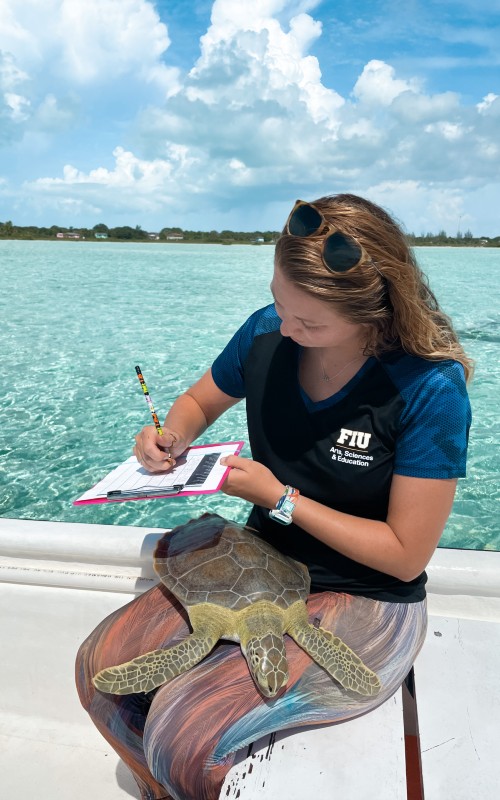
Awardees of the NSTSTF Rehabilitation and Outreach Award
- Hannah Virgin
Hannah Virgin is especially interested in linking environmental factors with sea turtle health. She has veterinary technician experience and was trained in taking blood samples from turtles. She used this summer internship as a pilot field season to assist the Loxahatchee River District and Palm Beach County. As part of this work, she scoped out the field sites and begin collecting preliminary data. For her graduate work she plans to develop a dissertation research project that aligns with Loxahatchee River District and Palm Beach County's research priorities. In collaboration with Loxahatchee River District and Palm Beach County Hannah has access to long-term data sets on seagrasses, water quality, and turtle abundances. Those data combined with observations of foraging behavior will inform her work on turtle health that she will evaluate through physical examinations in the field and blood metrics.
- Alyssa Miguez and Sole Amadi
Alyssa Miguez and Sole Amadi worked on rehabilitation and outreach at the Marine Environmental Education Center (MEEC) during the summer of 2022. At the education center, they received training in animal husbandry for taking care of captive sea turtles and assisted in the establishment of education and outreach programs. They also assisted with research being done in the laboratory at the MEEC to be able to provide new information for educational purposes and to gain insight for possible future research projects.
Sole Amadi Alyssa Miguez